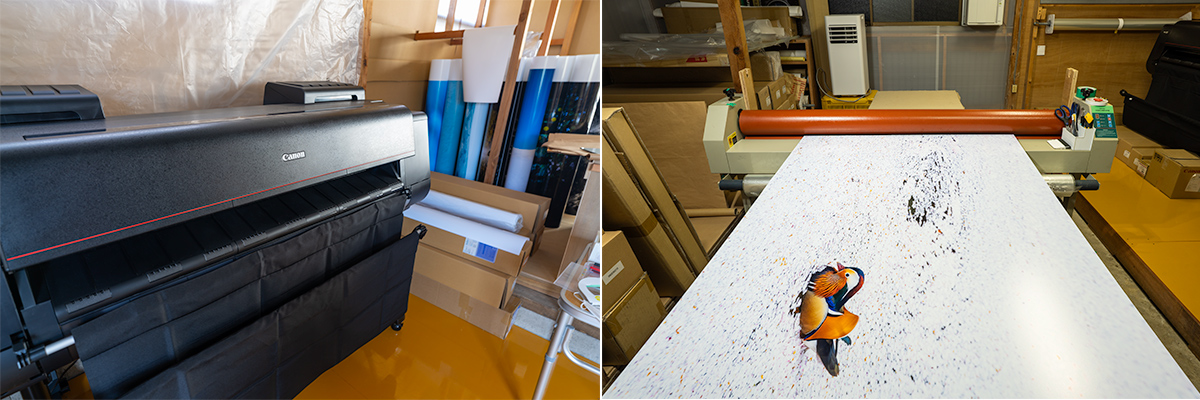Artist Statement
The English version is here.
「概要」
廣池は1962年生まれの日本の写真家です。2020年、世界最大規模のフォトコンテスト Sony World Photography Awards でプロフェッショナル部門のファイナリストに選出され、本格的に写真家としての活動を開始しました。以来、国際コンテストで継続的に受賞を重ね、現在は国際コンテストの審査員も務めています。さらに日本とポーランドでは美術館主催の個展が開催され、2024年には90年の歴史を持つ「ヤマケイカレンダー」に作家としてデビューしました。
彼は幼少期から渓流釣り、サイクリング、登山などのアウトドアを趣味とし、自然に親しんできました。広島大学工学部で黎明期のコンピューターに出会い、システムエンジニアとして産業用ロボットやCAD、Webシステムの開発に30年以上携わりました。その過程で写真表示プログラムを数多く開発したことが、やがて本格的に写真撮影へと向かう契機となりました。
彼は自然に畏敬の念を抱き、日本独自の自然・風景・文化を写真で表現しています。その根底には水墨画などの日本画からの影響があり、「うつろい」や「侘び・寂び」といった日本的な美意識が息づいています。また「写真とは何か」「美しさとは何か」を、エンジニアの視点から技術的かつ哲学的に探求しています。
新たな表現として、写真を「四次元空間(3次元の立体空間+時間)を二次元平面に変換する装置」と捉え、時間と写真の関係を研究。そして、生き物の動きやICM(Intentional Camera Movement)によって生まれる偶然性を生かし、デジタルカメラの特性を活かした「シュルレアリスム」を再構築しました。
彼は「物としての写真」にもこだわり、高精細な撮影に加え、一般的には専門業者に委ねる「プリントと額装」にも自ら挑戦しています。自宅に大型プリンターやパネル加工機を導入し、2m×1mの大型プリントと、アルポリック加工を自ら行い、木製額に加えて独自設計のアルミ額も開発しています。
「序章」
廣池は1962年、自然豊かな日本の鳥取県で生まれ育ちました。幼少期から山や川で遊び、渓流釣り、サイクリング、登山などを通して自然と深く関わってきました。幾度か命の危険を感じるような経験も経て、自然への畏敬の念を抱くようになります。家を建てる際には、北海道の山林にログハウスを建て、生活と趣味の両方で自然との結びつきを大切にして来ました。
広島大学工学部で黎明期のコンピューターと出会った彼は、システムエンジニアとして産業用ロボットやCADの開発に携わり、「特種情報処理技術者」という当時システム開発の最高位の国家資格も取得しました。29歳で独立後は、WEBシステム開発とデザインに注力。全国規模のホームページコンテストで2位を獲得した実績もあります。そして、写真の表示プログラムを数多く手掛けたことがきっかけとなり、本格的に写真を撮り始めます。
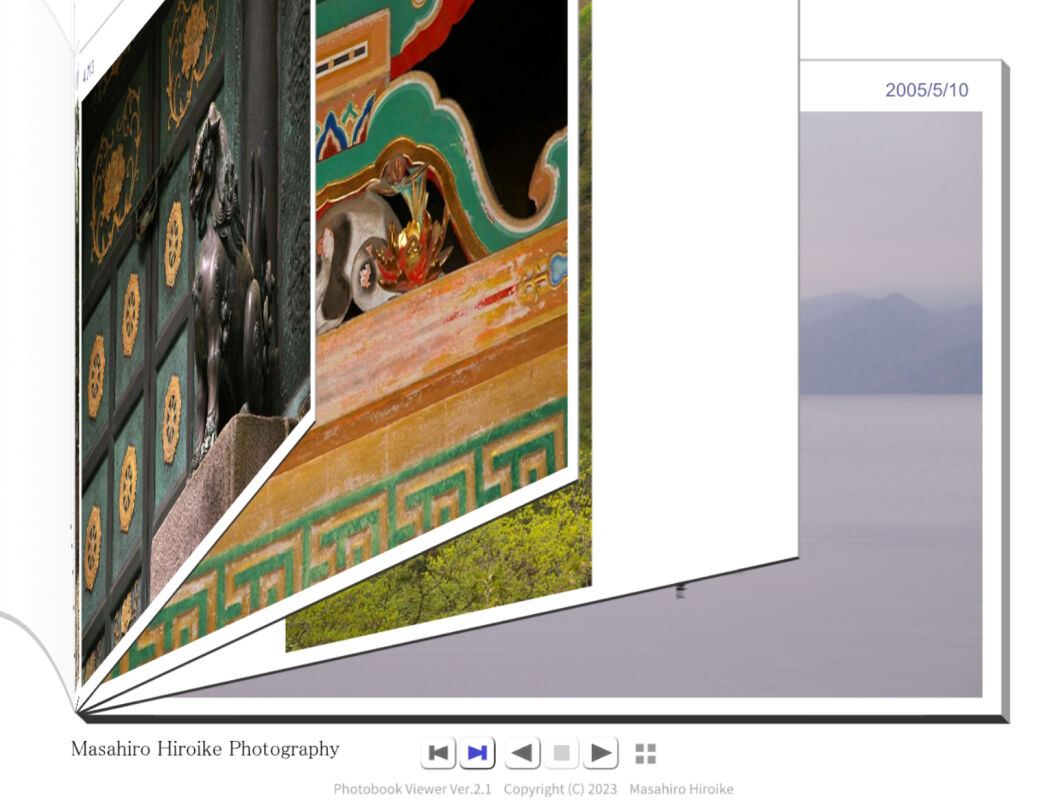
「写真家へ」
廣池はまず、国内の主要なフォトコンテストに挑戦を始めました。2015年には富士フイルムやニッコールなどで入賞を果たし、オリンパス・オープン・フォトコンテストではグランプリを受賞。これを機に、ナショナルジオグラフィックの「Your Shot」をはじめとする国際的な写真コミュニティに活動の場を広げ、海外のフォトコンテストにも積極的に応募するようになりました。
2020年、世界最大規模のフォトコンテスト、Sony World Photography Awards (SWPA) のプロフェッショナル部門「自然・野生生物」カテゴリーで第2位を受賞。しかし、新型コロナウイルスの世界的な拡大により、授賞式や展示会はほとんどが中止となりました。それでも、この受賞は大きな反響を呼び、彼のFacebookには海外から多数の友達申請が寄せられ、現在では世界109カ国、約4,000人とつながっています。
Facebookで知り合ったポーランド・下シレジア写真家協会の会長、Zibi氏との出会いもその一つです。彼は2020年11月にポーランドでの写真展を企画してくれましたが、コロナの影響で延期となり、最終的に2023年5月に開催されました。
2020年は「35AWARDS」など、他の国際コンテストでも成果が相次ぎ、廣池はプロの写真家となることを決意します。2021年には鳥取県の補助金を受けて、米子市美術館での大規模な個展を開催しました。
2024年と2025年には90年の歴史を持つ日本の老舗自然カレンダー『ヤマケイカレンダー(山と溪谷社)』の作家に、数多くの風景写真家の中から選出されました。
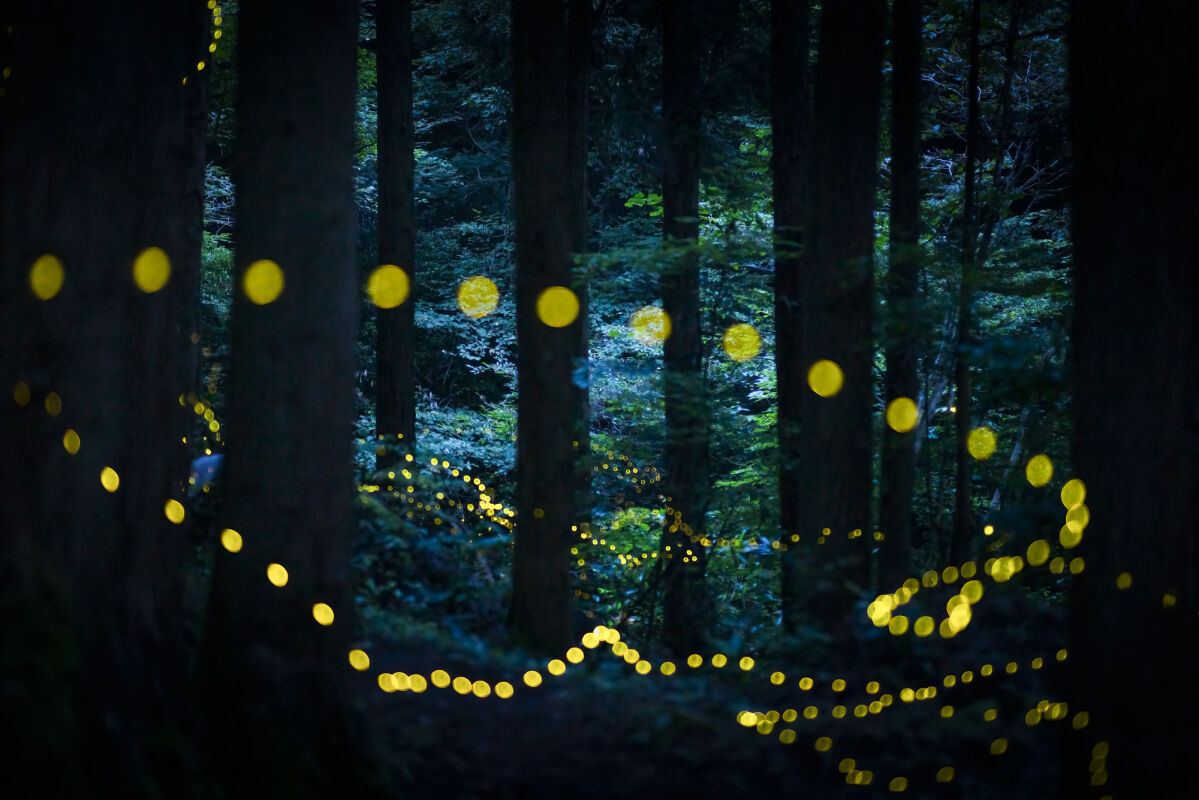
「美の探求」
廣池は、自然の風景や動植物、抽象的な表現を用いた作品まで、多様な被写体を通して一貫したテーマを追求しています。それは「美の探求」です。
写真家としてのキャリアをスタートさせた時、彼を突き動かしたのは「美しい写真を撮りたい」という純粋な思いでした。しかし、その根源にある「そもそも人間は何をもって『美しい』と感じるのか?」という問いは、エンジニアの彼を技術的・哲学的な探求へと導きました。
「美しい」という感情は、対象そのものが持つ美しさと、それを見る人の「美意識」との共鳴によって生まれます。この美意識は、生物としての本能や、生まれ育った風土、個人的な経験、学んだ文化や歴史など、非常に多様で奥深い要素によって形成されます。特に日本には、一見美しくないと感じられるものにも美を見出す独特の感覚があります。
彼はこの「人は何に美を感じるのか」という問いを大きなテーマに据え、写真を撮り続けています。

「日本の美」
廣池の原点は風景写真です。彼は自然との深い関わりと水墨画など日本画から受けた影響を背景に、日本の稀有な自然や風景、そこから生まれた文化を、日本人独特の「移ろい」や「侘び・寂び」の美意識を通して、写真というメディアで表現しています。
日本は細長い島国で、世界でも稀な、海・山・川が織りなす複雑な地形と、明確な四季の移り変わり、変化に富んだ気候を持っています。この豊かな自然は、美しい光景や清らかな水、豊かな食べ物を与えてくれる一方で、時に水害や地震といった災害で人々の命を奪う存在でもあります。日本人は古来より、この自然を畏れ敬いながら共生し、自然界のあらゆるものに神が宿るという「八百万の神」という思想から、「神道」という信仰を育んできました。同時に、「花鳥風月」や「雪月花」という言葉に象徴されるように、自然に「美」を見出してきたのです。
日本人の美意識には、「簡素」「静寂」「調和」「曖昧」「繊細」といった要素を「美」として捉える傾向があります。さらに、自然の移ろいや変化に対して、「無常」「もののあはれ」「幽玄」「侘び」「寂び」といった独自の感性も見出してきました。日本人にとって自然は信仰の対象であり、美意識の源泉でもあり、水墨画をはじめとする日本画や工芸をはじめとする文化芸術に結晶しています。そして、この美意識は、食や住まい、生活様式のみならず、企業理念や社会倫理にも深く根付いています。日本人にとって、風景には神が宿り、美意識には精神性も含まれているのです。
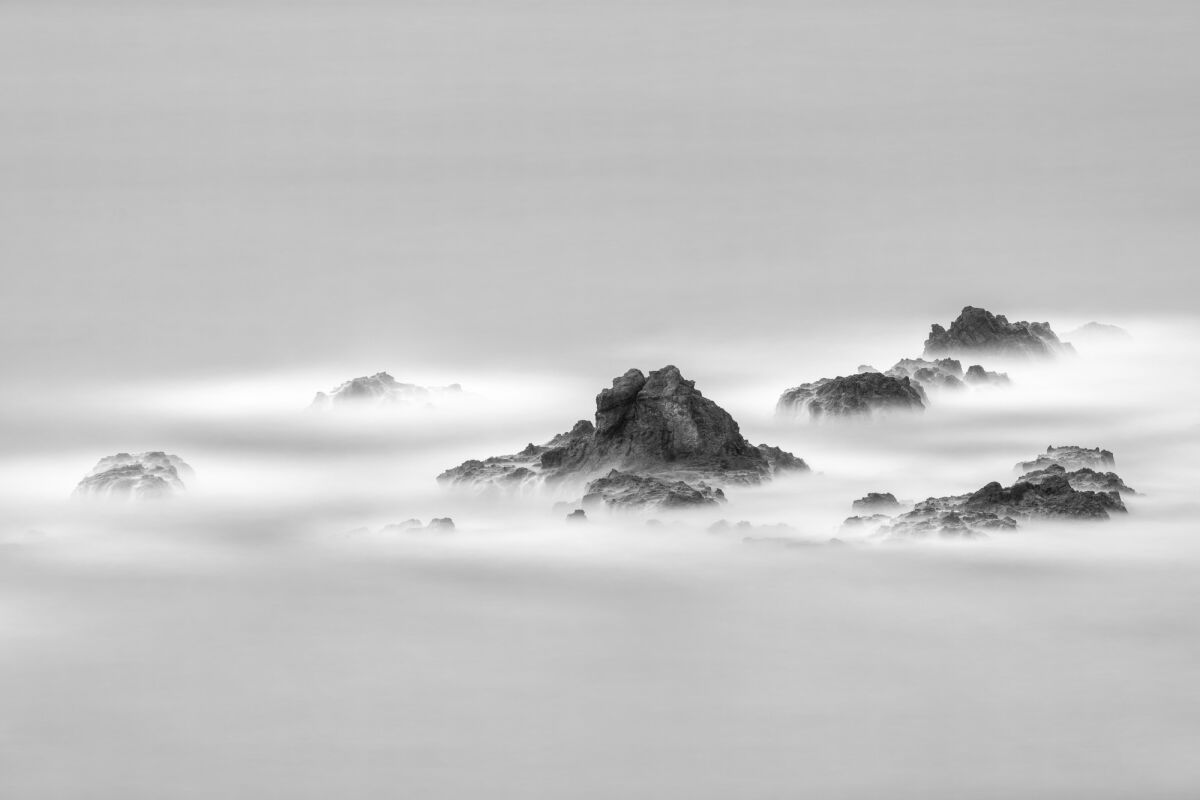
「写真と時間」
「ヒメボタル」は 廣池が10年以上取り組んでいる小さな蛍です。撮影を始めたきっかけは、夜の森に飛び交う光の美しさに魅了されたことでした。しかし次第に、ヒメボタルの写真には「写真とは何か」という概念に関わる大きな示唆が潜んでいると感じるようになりました。
ヒメボタルの撮影には、通常、複数枚を比較明合成する手法が用いられます。しかし廣池は撮影時間帯と露光時間を工夫する事で、一枚撮りでの撮影に成功しました。ヒメボタルは日没後、暗闇が深まるにつれて飛び始めます。廣池は背景の明るさに合わせて露光時間を設定しますが、その時間は森が暗くなるにつれて、5秒、10秒、20秒、30秒、1分、2分と次第に長くなっていきます。ヒメボタルはフラッシュのように瞬間的かつ一定間隔で発光するため、写真には点の連なりとして写り、レンズの近くを通れば玉ボケとして表れます。ここで重要なのは、露光時間はヒメボタルの光の明るさには影響せずに、写真上に現れる点や玉ボケの数に影響する事です。つまり、露光時間は、背景とヒメボタルの光跡とで異なる意味を持つのです。
写真はフランスでダゲレオタイプが発明された当初、数十分の露光時間が必要でした。それ以降フイルムやカメラは瞬時に撮影できるように進化を続け、今では数万分の一秒の露光時間で撮れるようになりました。その為か「写真は瞬間を記録するもの」とか「写真は3次元を2次元に変換する装置」と考えられるようになりました。しかし私たちが生きているのは3次元の立体空間に時間の流れる4次元世界です。したがって「写真は4次元(3次元の立体空間+時間)を2次元に変換する装置」とも言えるでしょう。その時間は被写体毎に異なる意味を持ち、場合によってはカメラの動きも含まれます。こうした視点を持つことで、写真の可能性は一気に広がります。
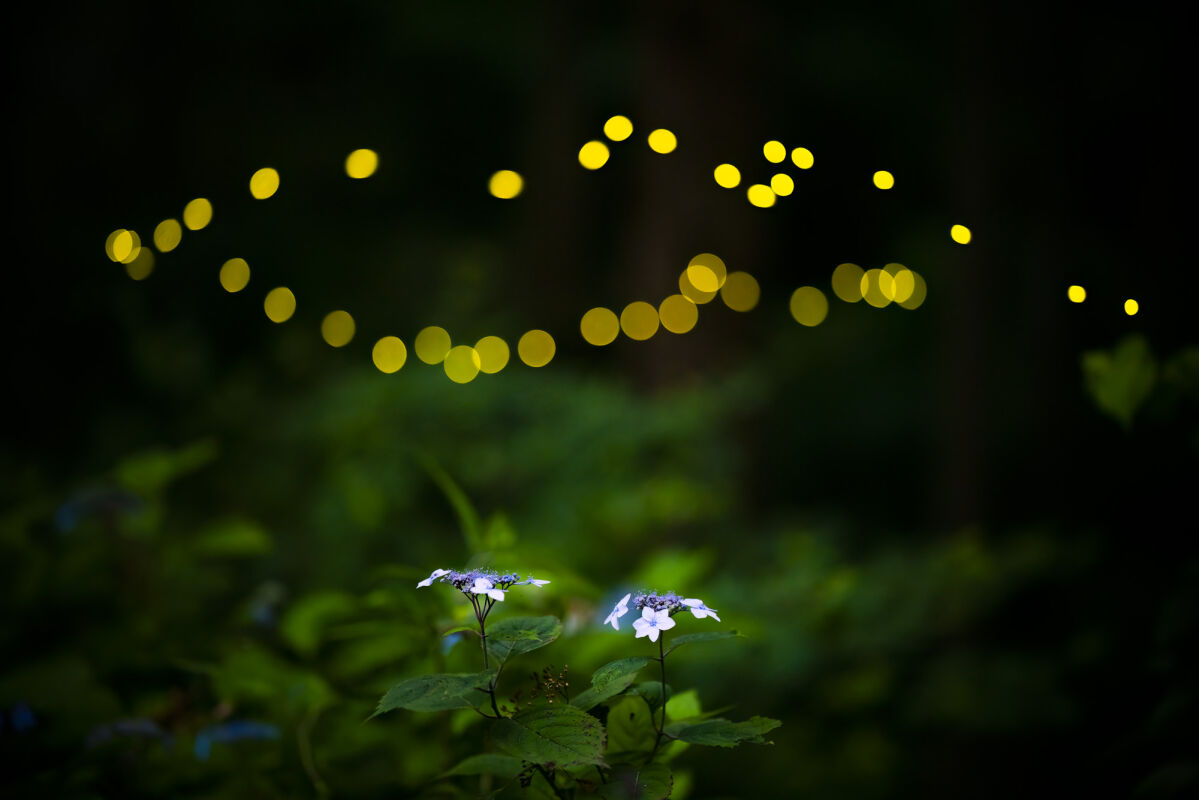
「デジタル写真によるシュルレアリスム」
ヒメボタルの撮影を通して、廣池はもう一つの重要な概念、「シュルレアリスム」にたどり着きました。
ヒメボタルは撮影者の思い通りには飛んでくれず、その光跡はすべて偶然に委ねられています。そのため彼は、タイマー・レリーズを装着した複数台のカメラで一晩に約1000枚を撮影し、6月初旬から7月末までほぼ毎日撮影を続けます。シーズン中の総枚数は4万枚を超えますが、作品として選ぶのはわずか20〜30枚です。
ある時、「偶然に撮れた写真を果たして自分の作品と呼べるのか?」という疑問が生まれました。調べるうちに、偶然性を芸術の核に据えた100年前の運動―シュルレアリスムに出会ったのです。
1924年10月、フランスの詩人アンドレ・ブルトンが「シュルレアリスム宣言」を発表し、人が認知する現実に無意識という新たな光を当て、現実を超えた「超現実」の世界を描こうとする芸術運動が誕生しました。この運動は「夢」を描いた絵画で知られますが、偶然に生まれた形や模様を無意識下の感覚で受け取り、それをもとに描かれた作品群も存在します。
写真はそもそも現実を映す装置ですが、「写真は4次元(3次元の立体空間+時間)を2次元に変換する装置」と考える廣池は、その時間を使って「現実」の写真表現の幅を広げました。そしてヒメボタルの光跡の偶然性との対話を通じて、デジタルカメラの特性を最大限に活かし、また、より科学的になった無意識の研究も踏まえて、「デジタル写真におけるシュルレアリスム」を再定義しました。
偶然性を持った膨大な写真の中から選ぶ
デジタルカメラでは、フィルム時代には物理的・経済的制約から不可能だった膨大な枚数の撮影が可能です。ヒメボタルの写真のように偶然性を持たせて撮影した数千枚の中から1枚を選ぶことは、自身の無意識下の感覚と共鳴する1枚を見つけ出し、無意識の美を可視化する事です。
偶然性を持った写真を基に再撮影する
デジタルカメラでは、その場で画像を確認できることが大きな特徴です。廣池は、日本の花火やクリスマス・ライトなどをICM(Intentional Camera Movement)で撮影しています。ICMではカメラを自由に動かすことで偶然性のある写真を撮ることができ、その場で確認・調整しながら再撮影することも可能です。これは、偶然によって生まれたイメージを作家の意図で再構築する創造的なプロセスです。
これらのアプローチは、歴史的な芸術運動であるシュルレアリスムが追求した偶然性の概念を、現代のデジタル技術と結びつけて再解釈したものです。廣池の作品は、単なる現実の記録ではなく、偶然と必然、そして理性を超えた無意識との対話から生まれる、現代における「超現実」の探求なのです。
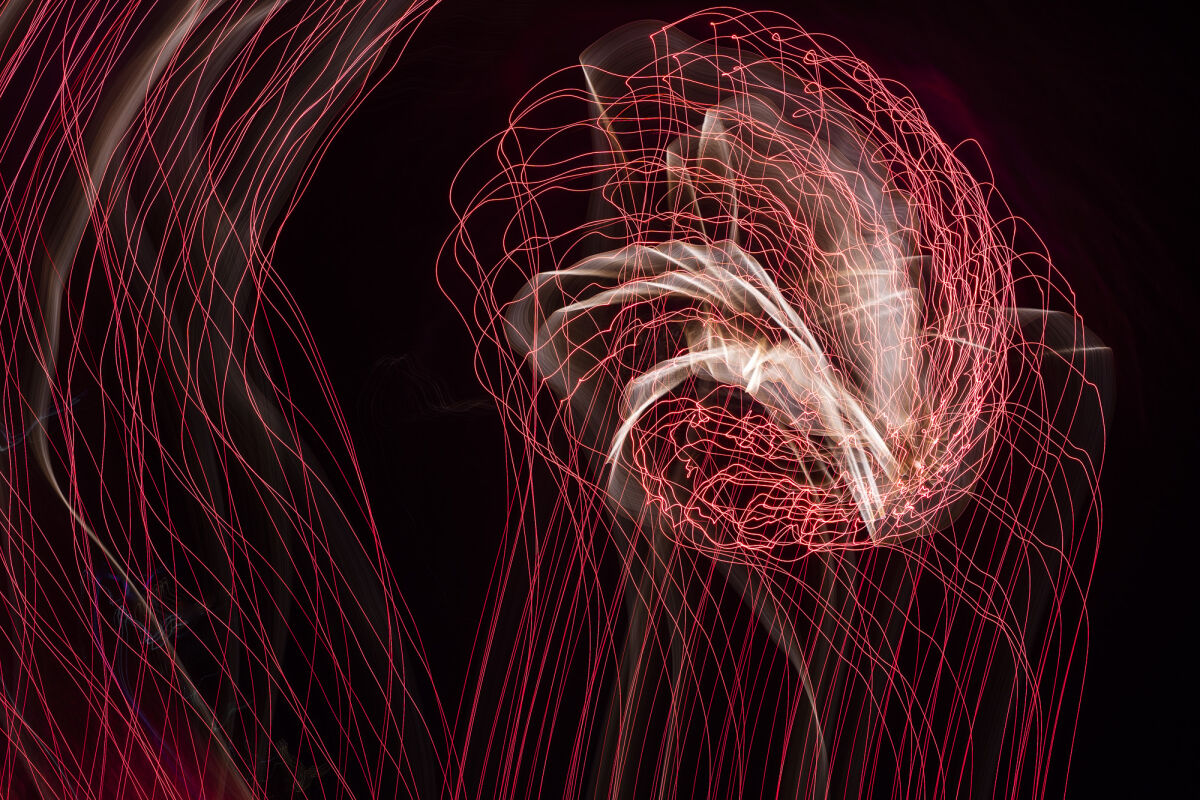
「アクション・フォトグラフィー」
画家ジャクソン・ポロックは、シュルレアリスムの延長線上で「アクション・ペインティング」を生み出しました。廣池のICM(Intentional Camera Movement)作品もまた「動き」を軸に展開し、写真を「描く」表現へと進化させています。彼はこのアプローチを「アクション・フォトグラフィー」と名付けました。
ICMでは、花火やクリスマスライトの光を時間の流れに沿って引き延ばし、その変化を地震計のように記録することができます。たとえば、クリスマスライトのLEDは交流の周波数で点滅しますが、カメラを動かしながら撮影すると、その光跡は点線となって現れます。花火の場合も、小さな火花の分裂や色の変化が繊細に写し取られ、光そのものが独自のマチエール(絵肌)を描き出します。
さらに、光のエネルギーと身体の動きが交錯し、相乗効果によって複雑さが増すと、宇宙や生命体を思わせる形が立ち現れます。偶然と必然、動きと時間、光と身体が重なり合うことで、写真はもはや単なる記録ではなく、描かれた「超現実の夢」として生成されるのです。
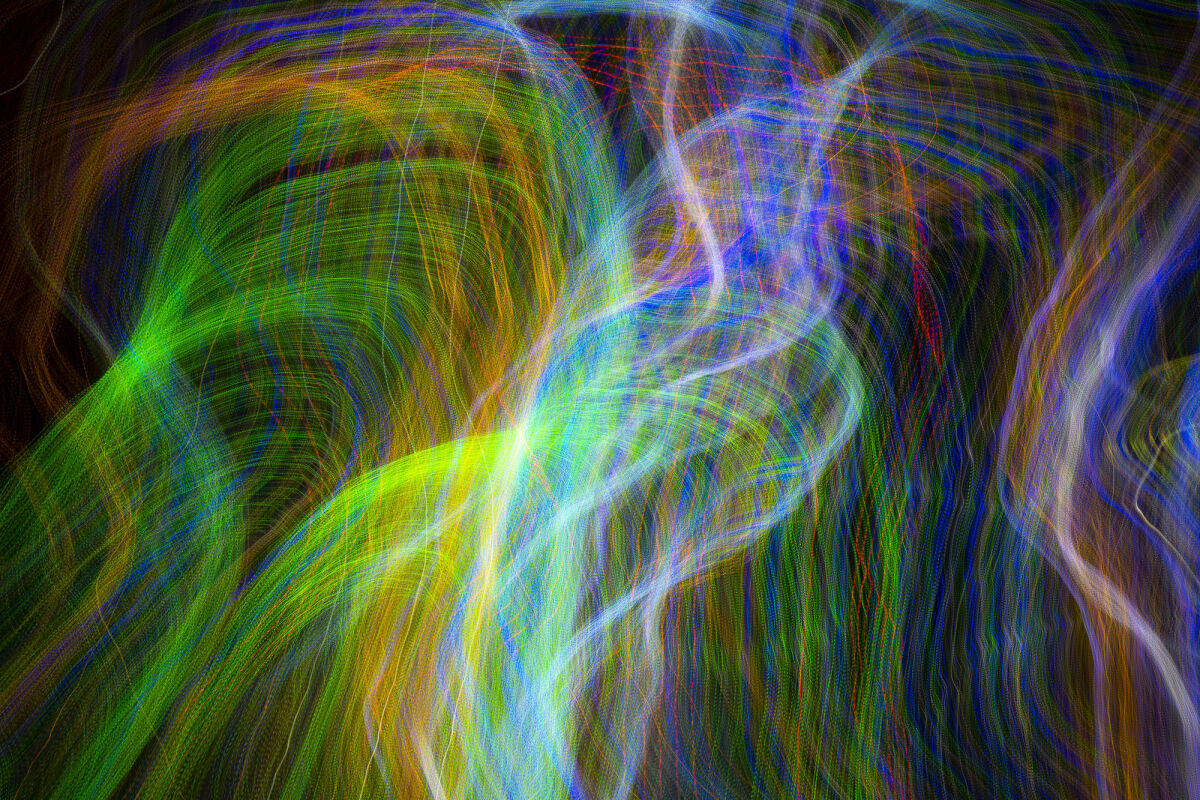
「高精細な表現領域の探求」
廣池が一貫して追求しているテーマは「美の探求」ですが、絵画において「細密画」というジャンルがある事でも明らかなように、現代の写真において「高精細」は「美しさ」の重要な要素の一つだと考えています。また、日本は世界に誇るカメラ・プリンター大国で、デジタルカメラの世界シェアの90%以上、プリンターシェアの50%以上を占めています。長年システムエンジニアとしてスライドショープログラムなどの開発に携わってきた廣池は、日本人としてこれらの写真関連技術に深い誇りを抱いてきました。そのため、写真家として活動を始めるにあたり、誰よりも「高精細な写真」を追求しています。
高精細化による表現の拡張
近年の高解像度デジタルカメラ、画像処理ソフト、そして大型プリンターの進化は、従来想像もできなかった「高精細な大判プリント」を可能にしました。B0(1.5m×1m)を超えるサイズでも虫眼鏡を使わなければ確認できないほどの緻密な表現が実現できます。
廣池は、B0以上のサイズを前提に、高解像度で撮影する事と、PCによるパノラマ合成と超解像技術を磨いています。この圧倒的な解像度は、写真に新たな迫力を与えると共に、「広大な風景の中に生きる動物」といった、従来のプリントサイズでは不可能だった新たな表現を可能にします。これは単なる品質向上ではなく、表現領域を拡張する試みです。
エンジニアリングの集大成としての制作プロセス
これまで、日本の写真家は、大判のプリントや額装は専門業者に委ねてきました。大判プリントは「パネル貼り」が必要になりますが、そこには専門の道具と技術が必要となり、とても高価になります。廣池は写真展で「高精細な大判プリント」を主体に展示するために、「プリントと額装」に自ら挑戦してきました。
彼は趣味の木工とロボット開発の経験を活かし、自宅の車庫をプリント工房にリフォーム。そこに44インチ対応の大型プリンターと1600mm幅のコールドラミネーターを導入して、B0サイズのプリント制作やアルポリック加工(アルミ複合版によるパネル化)を行っています。また、既成の木製額に加え、独自設計のB0サイズ用のアルミ額も開発しています。
彼の写真作品は、日本の技術に対する敬意と、エンジニアリングによって裏打ちされた、徹底的な高精細へのこだわりの集大成なのです。
